How Not to Get Distracted While Studying
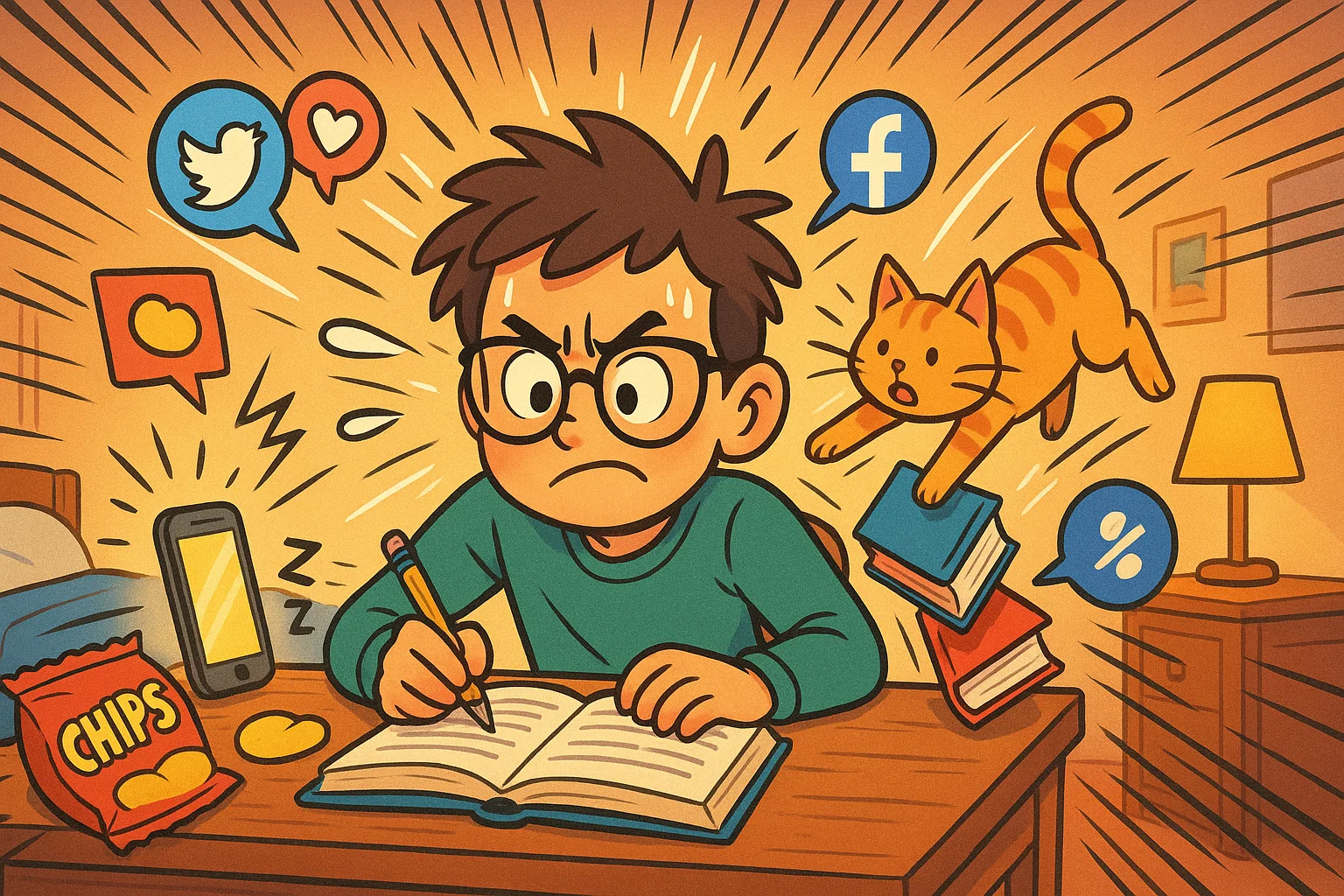
We’ve all been there—you sit down to study with good intentions, and minutes later your phone, a messy desk, or racing thoughts pull you off track. In today’s digital world, staying focused is one of the biggest challenges to effective learning. Whether you’re a student or an adult learner, managing distractions is key to real progress.
This guide, grounded in behavioral psychology, shares practical strategies to overcome both internal and external distractions. You’ll learn how to create an ideal study environment, structure focused sessions, and build the mental resilience needed to stay on task and study efficiently.
Why It’s Hard to Stay Focused While Studying
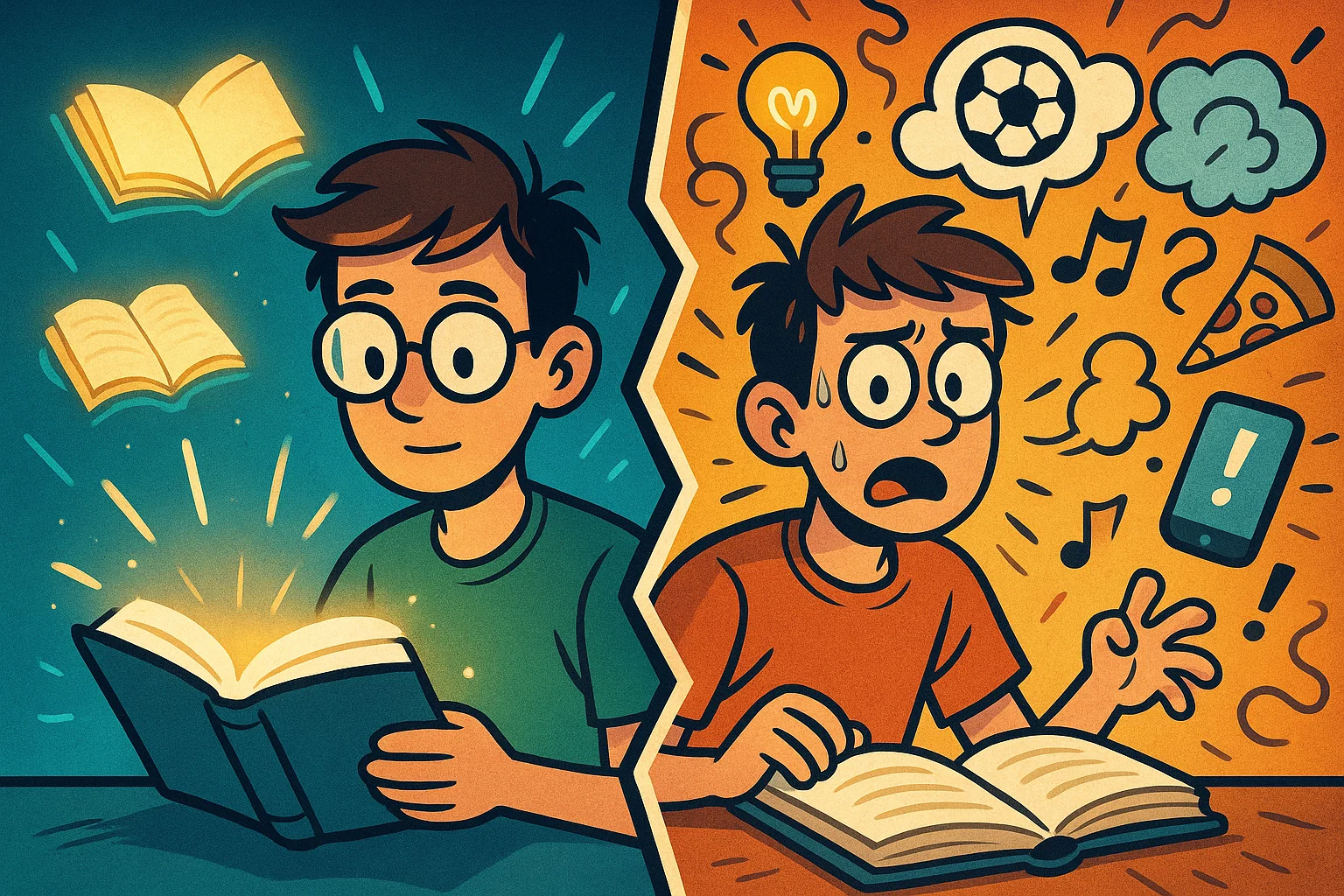
Understanding the mechanics of distraction is the first step toward overcoming it. Why do we get distracted so easily, even when we truly want to focus? It’s not a moral failing; it’s a feature of the human brain, amplified by modern technology.
The psychology of distraction is rooted in our brain’s natural tendency to seek novelty and avoid discomfort. The brain loves the quick reward system offered by things like checking a text or scrolling on TikTok because these actions release dopamine, the “feel-good” neurotransmitter. This creates a loop of instant gratification. When you’re trying to study dense or difficult material, your brain is seeking a cognitive shortcut, and that phone notification or an interesting thought offers an immediate, easy reward compared to the sustained effort required to focus on one thing.
For example, when you tell yourself you’ll check notifications “just for a second,” that small action reinforces the brain’s preference for easy dopamine hits over challenging work. Over time, this makes it incredibly easy to get distracted because the brain becomes conditioned to seek escape whenever difficulty arises. This is why many students struggle with distractions—it’s a neurological battle against highly effective, well-designed dopamine triggers.
Internal Distractions: Thoughts and Emotions
These are the distractions that come from within. They are often less obvious but just as damaging to your concentration as any external noise. Internal distractions include stress, anxiety, hunger, boredom, and physical discomfort.
| Internal Distraction Type | How It Reduces Attention Span | Actionable Tips to Help You Stay Focused |
| Stress & Anxiety | The mind races, focusing on worries instead of the study material. It creates a “fight or flight” state that makes sustained cognitive effort difficult. | Practice brief mindfulness or deep breathing before and during a study session. Use a journal to quickly dump anxious thoughts before you start. |
| Boredom/Fatigue | The brain seeks novelty to stay stimulated, making you want to check your phone, look up a random fact, or simply quit studying. | Switch learning styles—for example, move from reading to sketching a concept map—and take short, strategic breaks. |
| Hunger/Thirst | Basic physical needs become overwhelming signals that pull attention away from your work. | Keep water and healthy, non-messy snacks (like nuts or fruit) at your desk. Address physical needs before you sit down to study. |
When these internal states arise, your ability to maintain focus is significantly lowered. You might get distracted while studying simply because you’re physically uncomfortable or mentally overwhelmed.
External Distractions: Technology and Environment
These are the obvious culprits—the things in your environment that pull your attention away from your work.
- Phones and Messages: The constant chime of notifications.
- Background Noise: Loud family members, traffic outside, or a distracting TV.
- Visual Clutter: A messy desk or an overly stimulating environment.
According to The Mere Presence of a Cell Phone May Be Distracting found that even when a phone is not in use, its mere presence reduces attention and task performance. Minimizing these external triggers through careful study space setup is essential to avoid distractions while studying.
The Role of Motivation and Mindset
If you lack a clear goal or sense of purpose, your brain has no reason to prioritize studying, making it easier to focus on anything else. When students feel overwhelmed by a difficult task or a lack of clear direction, they are much more likely to resort to procrastination and distraction. A growth mindset, where challenges are seen as opportunities for learning rather than threats, significantly improves resilience against distraction.
How to Create a Distraction-Free Study Space
Your physical environment is the first line of defense against both internal and external distractions. A dedicated and optimized study space acts as a powerful cue to your brain that it’s time to study and focus.
Choose a Quiet and Comfortable Spot
Your workspace should ideally be a quiet place reserved only for studying. This helps create a mental boundary.
- Lighting: Use bright, natural light whenever possible. Dim lighting can cause eye strain and signal your brain to wind down.
- Temperature: A slightly cool temperature (around 68°F/20°C) is often cited as optimal for concentration, as being too warm can induce sluggishness.
- Posture: Invest in an ergonomic chair. Poor posture not only causes physical discomfort (an internal distraction) but also signals fatigue.
Organize Your Desk and Materials
A cluttered desk leads to a cluttered mind. Visual order promotes mental clarity.
| Action | Benefit for Studying Effectively |
| Declutter | Remove everything not directly related to your current task (e.g., magazines, random gadgets, old notebooks). You want visual simplicity. |
| Keep Essentials Handy | Have your required books, pens, notebooks, and calculator ready before you start. Searching for items is a common way to get distracted. |
| Create a “Command Center” | Use a simple to-do list or planner to keep your immediate task list visible, helping you focus on one thing at a time. |
Manage Noise Levels
The ideal sound environment varies by individual learning style.
- Silence: For some, absolute silence is best. If your home isn’t quiet, noise-canceling headphones are an excellent investment.
- Background Sound: For others, silence is too stark and allows internal distractions to surface. In this case, listening to classical or instrumental music can be highly effective. The key is to choose music without lyrics, as lyrics engage the language centers of the brain and compete with your study material.
- White Noise/Brown Noise: These consistent sounds mask sudden, distracting noises (like a phone ringing in another room) and help maintain focus.
- Instrumental music (e.g., movie scores, Lo-Fi playlists, or non-lyrical jazz) helps students focus without diverting attention.
Limit Technology Around You
The easiest way to avoid distractions is to remove the source.
- Go Analog: If possible, use physical books, printouts, and notebooks. This removes the temptation of digital distractions present on your computer screen.
- Use “Airplane Mode”: Put your phone on airplane mode and place it in a drawer or another room. Out of sight, out of mind.
- Dedicated Study Device: If you need a computer for online learning or research, use it strictly for that purpose. Close all irrelevant browser tabs.
How to Manage Internal Distractions
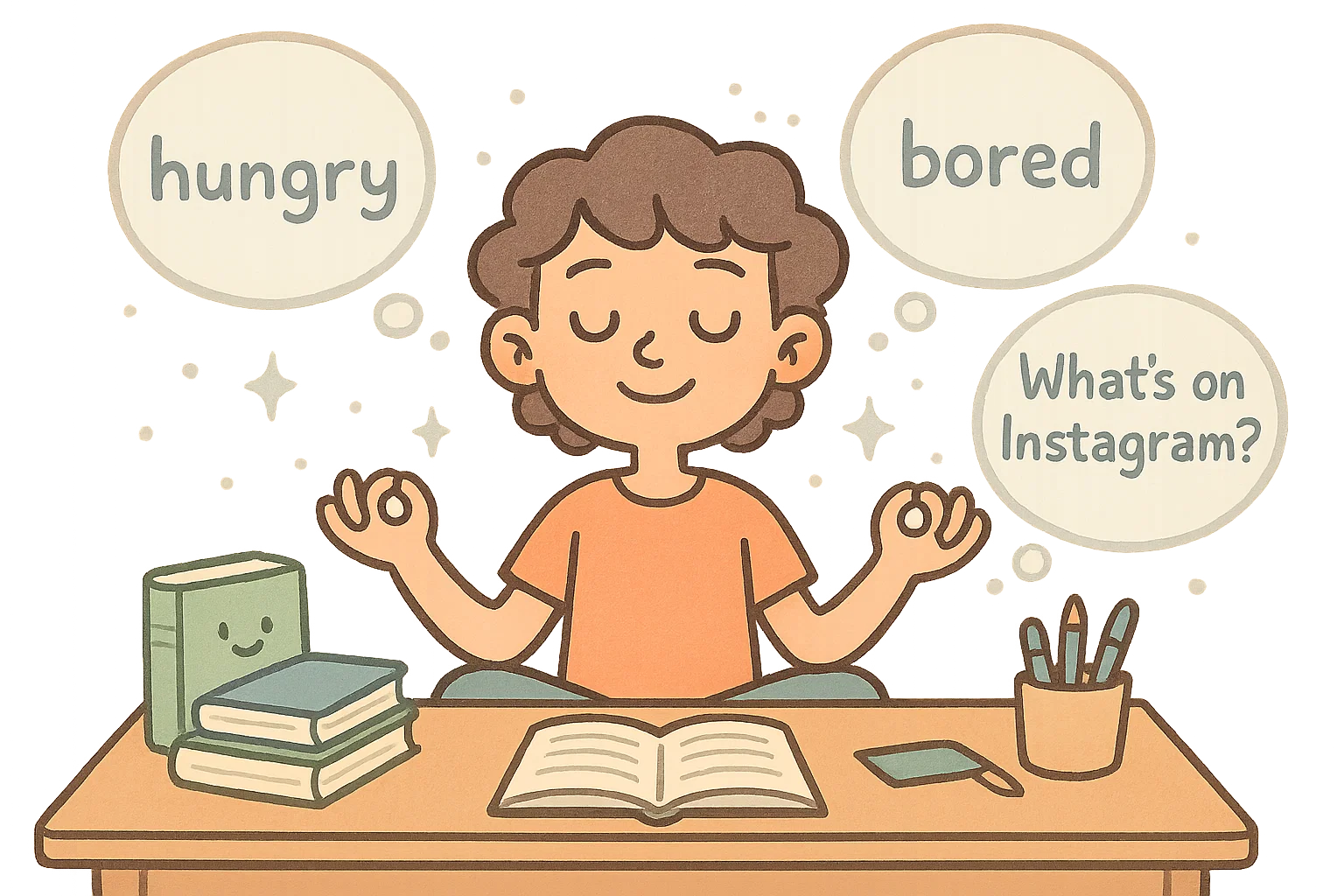
Once your environment is set up, the next battle is with your own mind. Learning how to focus involves practicing mental techniques that help you redirect your attention when it wanders.
Practice Self-Awareness and Mindfulness
This is about recognizing when your attention is straying before you act on the distraction.
- Short Breaks: Integrate short, mindful breaks (30 seconds to a minute) every 25-50 minutes. Simply close your eyes and focus on your breath. This helps reset your focus.
- Body Scan: Briefly check in with your body. Are you tense? Are you hungry? Addressing these physical feelings can eliminate a significant source of internal distractions.
Reframe Negative Thoughts
When you hit a difficult section, it’s common to hear an inner voice say, “This is too hard,” or, “I can’t focus on one thing.”
- Challenge the Thought: Instead of accepting “I can’t focus,” rephrase it to be productive: “I struggle with distractions right now, so I will take a 30-second break, adjust my posture, and start on the next small paragraph.”
- Adopt a Growth Mindset: Replace “I’m bad at this” with “I am learning, and this challenge will make me better.” This prevents feeling overwhelmed, which is a key driver of the urge to scroll or look for an escape.
Apply the 3-Step Method to Identify Triggers
In his book Indistractable, Nir Eyal suggests a powerful method for managing triggers:
- Identify: When you feel the urge to get distracted (e.g., an itch to check your phone, a sudden thought of getting a snack), simply name the sensation.
- Record: Jot down the feeling (e.g., “Feeling bored,” “Feeling anxious,” “Physical restlessness”) on a piece of paper or in a quick note.
- Explore: Instead of instantly acting on the distraction, observe the sensation for 10 seconds. How does the feeling change? This small pause gives you the conscious power to choose your response instead of reacting automatically.
Avoid Ego Depletion and Burnout
The so-called ‘willpower depletion’ myth often leads to giving up. While willpower is a finite resource in the short term, the capacity for self-control can be strengthened.
- Schedule Restorative Activities: Ensure your study schedule includes genuine, restorative activities that aren’t screen-based. This helps the brain recharge and makes it easier to focus during your next study session.
- The Power of Small Wins: Don’t wait until you’re completely drained to take a break. Successfully completing a small task or a 25-minute Pomodoro interval gives you a boost that maintains energy and focus.
How to Manage Technology and Social Media
Technology is both a tool for online learning and the most powerful source of modern distractions during your study. Mastering digital distractions is essential for effective studying.
Turn Off Notifications or Use Focus Mode
This is non-negotiable for anyone who wants to study without the constant interruption of a vibrating or chiming phone.
- Do Not Disturb: Most phones have a “Do Not Disturb” feature. Learn how to set it to allow only calls from emergencies.
- Focus Assist (Windows) or Focus (Mac/iOS): These operating system features allow you to block all apps and alerts except for the handful you need for studying. They actively help you focus by creating a digital barrier.
Schedule Specific Times for Checking Messages
Compulsive checking ruins study time. Instead of randomly checking your phone, set specific social media slots into your study schedule.
- Example: Only allow yourself to scroll or check TikTok during a 10-minute break after every two hours of studying. Knowing you have a specific time coming up makes it much easier to put off the urge when it arises. This method greatly helps you avoid digital distractions.
Use Apps That Block Distractions
A variety of apps are designed to physically and digitally prevent you from getting distracted.
| App Category | Examples | How It Helps Students |
| Website Blockers | Freedom, Cold Turkey, StayFocusd | Block access to time-wasting websites (like social media, news sites, or even watching YouTube) during your set study time. |
| Gamified Focus Apps | Forest | You plant a virtual tree when you start a session; if you leave the app, the tree dies. Uses a simple reward/punishment system to promote focus. |
| Time Trackers | FocusMe, Toggl | Track how you spend time to build awareness of where your attention goes. |
Replace Screen Time with Productive Breaks
The brain needs a break, but switching from studying a textbook to watching YouTube is often just a change in distraction, not real rest.
- Move Your Body: Stand up, stretch, walk around the room, or do a few jumping jacks. Physical movement is excellent for fighting fatigue and eliminating internal distractions.
- Journaling/Brain Dump: Use 5 minutes to write down any lingering thoughts or tasks (personal or academic) that pop into your head. This prevents them from becoming intrusive internal distractions during the next session.
How to Structure Study Sessions
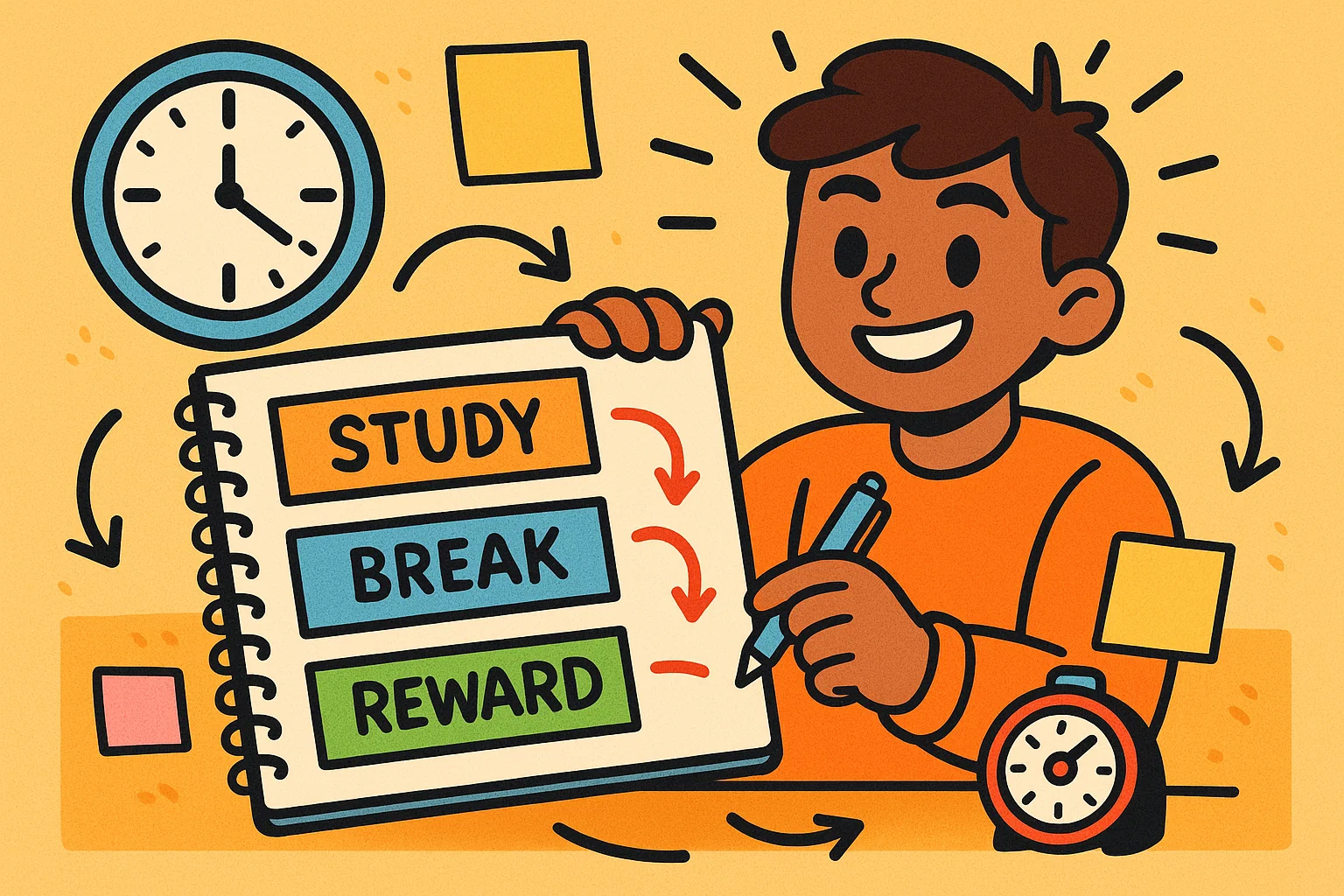
Even the most distraction-free environment won’t work if the work itself feels overwhelming. Breaking down large projects and structuring your time provides a clear pathway to maintain focus.
Make a Study To-Do List
Never start a study session without knowing exactly what you plan to accomplish.
- Prioritize: Use the Eisenhower Matrix or a simple A/B/C system to decide what needs your attention most.
- Be Specific: Instead of “Study History,” write “Review Chapter 3 notes and create 10 flashcards on the French Revolution.” Specific tasks are much easier to focus on.
Break Work Into Smaller Chunks
One of the best simple study methods to combat the feeling of being overwhelmed is the Pomodoro Technique, which helps prevent distraction.
- The Pomodoro Technique: Work for a hyper-focused, uninterrupted 25-minute interval, followed by a 5-minute break. After four cycles, take a longer, 20-30 minute break. This method trains you to focus on one thing for a manageable period, making it easier to start and stop getting distracted.
- Breaking Down Large Projects into Smaller Tasks: A massive research paper becomes a series of steps: 1. Research outline (2 Pomodoros), 2. Draft Introduction (1 Pomodoro), etc.
Take Regular Breaks
Breaks aren’t a sign of weakness—they’re an essential part of effective study. Scientific research suggests that brief breaks significantly enhance the ability to retain information and sustain attention.
- Hydration: Drink water. Dehydration is a subtle but powerful internal distraction.
- Eye Rest: Use the 20-20-20 Rule: Every 20 minutes, look at something 20 feet away for 20 seconds. This prevents eye fatigue caused by prolonged screen or book time.
Use Rewards for Motivation
Small incentives can create positive associations with your study plan and help you stay focused.
- Micro-Rewards: After completing a particularly difficult study session (e.g., three Pomodoros), reward yourself with a favorite snack, a few minutes of browsing a hobby site, or listening to instrumental music you enjoy.
- Goal-Based Rewards: Tie larger rewards (like watching a movie or meeting a friend) to the completion of a major component of your study goal.
How to Strengthen Focus Through Routine
Sustainable focus isn’t about one magic trick; it’s about building habits that support your cognitive function long-term.
Get Enough Sleep and Nutrition
Good focus starts long before you sit at your desk. According to research, chronic sleep deprivation significantly impairs executive functions, including attention and the ability to maintain focus.
- Consistency is Key: Try to go to bed and wake up at the same time every day, even weekends.
- Brain Food: Eat a balanced diet. High-sugar, high-fat foods cause energy spikes and crashes that lead to fatigue and make distraction more likely. Complex carbohydrates and lean proteins are better for sustained energy.
Set SMART Goals for Each Study Session
When you have clear, measurable goals, your attention has an anchor, which makes it much easier to focus and avoid distraction. SMART goals are:
- Specific
- Measurable
- Achievable
- Relevant
- Time-bound
- Bad Goal: Study Chemistry.
- SMART Goal: Read the two-page summary of the Periodic Table, answer all 15 review questions, and be finished by 4:30 PM.
Keep a Consistent Daily Schedule
Your brain thrives on predictability. Studying at the same time and in the same place every day trains your brain for focus through habit formation.
- “Focus Hours”: Identify the times of day when you naturally like to study (e.g., morning for high energy, late afternoon for deep thinking) and block off those periods in your study schedule. This maximizes your natural peaks of energy and attention.
Track Progress and Adjust Strategies
Self-evaluation is crucial for long-term improvement. You need to know which tips to help you focus are actually working.
- Use a Planner or App: Track how many focus blocks you complete, what you achieved, and what caused distraction.
- Be Flexible: If the Pomodoro Technique isn’t working for you, try a 50/10 split. If classical or instrumental music is distracting, try white noise. The best study plan is one that you can stick to.
When You Still Get Distracted: What to Do
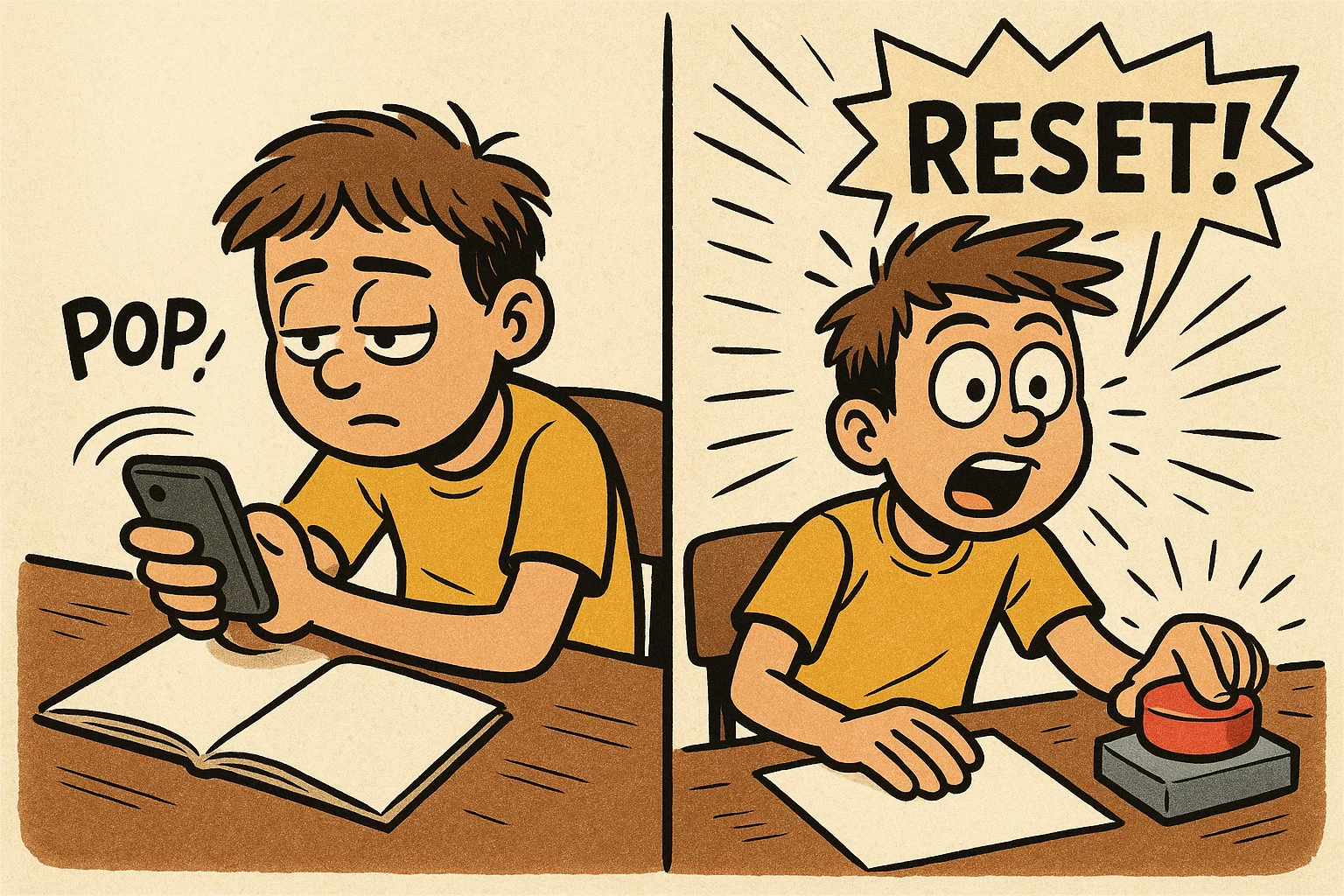
Even the most dedicated students end up getting distracted sometimes. Normalize these setbacks and have a plan to recover quickly.
Use the “Reset” Technique
Don’t let a small distraction derail your entire session.
- Stop: As soon as you realize you’re checking your phone or daydreaming, immediately stop the distracting behavior.
- Pause & Breathe: Take three deep, slow breaths. This simple act resets your nervous system and stops the emotional momentum of the distraction.
- Intentionally Restart: Say aloud, ‘I’m resetting my focus,’ and physically touch your study material or pick up your pen to resume work.
Change Study Methods
If you are stuck or repeatedly losing focus on one task, a shift in activity can re-engage your brain. This is a great way to handle distractions and focus.
- Switch from passive review (reading) to active recall (writing out answers or teaching the concept to a wall).
- If you’re writing an essay, switch from writing the body to outlining the conclusion. Variety can refresh attention and make it easier to focus.
Seek Accountability Partners
Having a commitment to another person can be a powerful antidote to procrastination and distraction.
- Study Buddies: Work on parallel tasks with a friend. The shared presence and social commitment can help both of you avoid distractions.
- Online Study Rooms: Join a virtual study session (many are available on YouTube) where you work alongside others. The social pressure of a silent, focused group often promotes focus.
How to Help Kids Avoid Distractions While Studying
For parents and educators, the principles of focus remain the same, but the application requires structure and external support. Helping children and teens learn to focus is a key life skill.
Create a Study Routine for Children
Structure provides a secure framework that minimizes confusion and decision fatigue—a major source of distraction for children.
- Consistent Time and Place: Designate a specific study space and a consistent time to study (e.g., 4:00 PM – 5:00 PM on weekdays). This trains the brain to associate that time and place with work.
- Visual Checklists: Use simple visual to-do lists so the child knows exactly what is expected. CChecking off each item gives a sense of accomplishment and keeps the child focused on the next task.
Reduce Screen Time During Homework
Digital distractions are particularly potent for developing brains.
- Parental Controls: Utilize parental controls or website blockers to limit access to distracting apps (like TikTok) during homework hours.
- Charging Station: Implement a central, non-bedroom charging station for phones and tablets, especially during study time and overnight. This actively removes the biggest source of distraction from the study space.
Encourage Short Active Breaks
Children have shorter attention spans than adults; long sessions are counterproductive and lead to children ending up getting restless.
- Movement Breaks: After 15-20 minutes of focused work, encourage a short active break—a few minutes of dancing, jumping rope, or stretching. This balances the need for movement with the need for focus on one thing during the work periods.
- Use Music: As with adults, allowing the child to listen to music (instrumental) can create a focusing atmosphere, especially when the home environment is noisy.
Key Takeaways and Conclusion: Focus Better, Study Smarter
Successfully managing study distractions is the cornerstone of studying effectively and improving academic performance. The difference between students who get distracted and those who maintain focus often comes down to their strategic preparation, not their inherent intelligence.
Here is a summary of the most important elements:
- Environment Control: Design a dedicated, minimal study space. Remove the phone, use noise-cancelling headphones if needed, and make your surroundings signal “work.”
- Mindful Behavior: Practice self-awareness. Use the Reset Technique when you inevitably get distracted. Address internal distractions like hunger, fatigue, and stress proactively.
- Structure and Planning: Break down large projects into smaller tasks using methods like Pomodoro. Set SMART goals so your attention has a clear, measurable target.
Remember, achieving better focus is not a passive event; it is a skill that must be actively trained. While nearly all students struggle with distraction, the good news is that this is something you can change. Be patient, experiment with different techniques, and adopt those that fit your personality and learning style.
Focus is a skill—the more you train it, the stronger it becomes. The ability to study without getting distracted will not only lead to higher grades but will also serve you well in every area of life that requires deep, sustained concentration. Go build your focus muscle!
